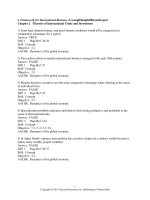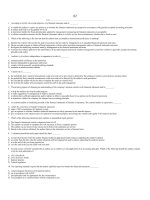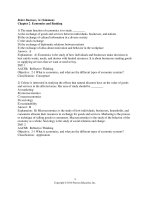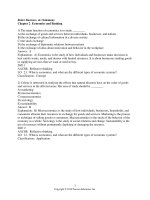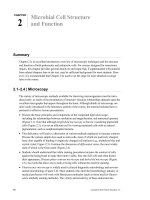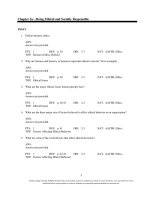International business 14th edition daniels test bank
Bạn đang xem bản rút gọn của tài liệu. Xem và tải ngay bản đầy đủ của tài liệu tại đây (325.86 KB, 30 trang )
International Business: Environments and Operations, 14e (Daniels et al.)
Chapter 2 The Cultural Environments Facing Business
1) ________ consists of specific learned norms based on attitudes, values, and beliefs of a group
of people.
A) Ethnology
B) Civilization
C) Culture
D) Doctrine
Answer: C
Diff: 1
Skill: Concept
Objective: 1
AACSB: Multicultural and diversity understanding
2) Which of the following is NOT true about cultural diversity?
A) Companies may gain competitive advantages by bringing together people of diverse
backgrounds.
B) Cultural diversity is most successful when domestic and foreign firms establish joint ventures.
C) Cultural diversity may help a company gain deeper knowledge about products and services.
D) The process of bringing people of different national cultures together is often difficult.
Answer: B
Diff: 3
Learning Outcome: Explain how differences in culture affect the international business
environment
Skill: Concept
Objective: 1
AACSB: Multicultural and diversity understanding
3) Because people can be grouped in many ways, such as on the basis of nationality, ethnicity,
religion, profession, and income level, ________.
A) people live in a state of cultural collision
B) cultural studies fail to understand behaviors
C) identity crises make individual's lives chaotic
D) people have more than one cultural group membership
Answer: D
Diff: 2
Skill: Concept
Objective: 1
AACSB: Multicultural and diversity understanding
1
Copyright © 2013 Pearson Education, Inc. Publishing as Prentice Hall
4) When divergent cultures come in contact, ________ occurs.
A) power distance
B) culture shock
C) cultural collision
D) group membership
Answer: C
Diff: 1
Skill: Concept
Objective: 1
AACSB: Multicultural and diversity understanding
5) Which of the following best describes a condition under which cultural collision would most
likely occur in international business?
A) A company implements practices that are less effective than intended.
B) Local employees are overlooked for promotions by home country managers.
C) Expatriate managers rely too heavily on local employees for negotiating business deals.
D) Foreign and domestic companies make adjustments for the local culture and legal
environment.
Answer: A
Diff: 3
Learning Outcome: Explain how differences in culture affect the international business
environment
Skill: Application
Objective: 1
AACSB: Multicultural and diversity understanding
6) Which of the following is the most accurate statement about culture?
A) Cultural variables can easily be isolated from other factors such as economic and political
conditions.
B) Although most cultural variables are universal, the forms these variables take differ from
culture to culture.
C) Most cultural variables are superficial and can easily be influenced by environmental factors.
D) Within a culture, everyone responds to particular cultural variables the same way.
Answer: B
Diff: 3
Skill: Concept
Objective: 1
AACSB: Multicultural and diversity understanding
2
Copyright © 2013 Pearson Education, Inc. Publishing as Prentice Hall
7) Businesspeople seeking to understand more about another culture in order to successfully
conduct business within that culture would be best advised to do which of the following?
A) observing the behavior of people who have gained respect within that cultural environment
B) relying on stereotypes, which are based on averages, to gain an understanding of the culture
C) avoiding cultural research studies because they perpetuate unjustified stereotypes and
behaviors
D) memorizing the cultural variations that are typically encountered in a specific cultural
environment
Answer: A
Diff: 2
Learning Outcome: Explain how differences in culture affect the international business
environment
Skill: Application
Objective: 1
AACSB: Multicultural and diversity understanding
8) Which of the following is a common shortcoming of studies examining culture in different
countries and regions?
A) Cultures are static, which leads researchers to draw false conclusions from old data.
B) It is impossible to compare countries because of differences in the form of data collected.
C) Responses are reported in averages, which can lead to a belief in unrealistic stereotypes.
D) People are reluctant to complain about their own cultures, so they present only positive
opinions to researchers.
Answer: C
Diff: 3
Learning Outcome: Explain how differences in culture affect the international business
environment
Skill: Concept
Objective: 1
AACSB: Multicultural and diversity understanding
9) The nation offers a workable reference for studying cultural differences because ________.
A) a nation contains only one distinct culture
B) similarity among people is both a cause and effect of national boundaries
C) the commonality of language within a nation eases the process of conducting surveys
D) different groups within the same country always have more in common with each other than
with groups in other countries
Answer: B
Diff: 2
Skill: Concept
Objective: 2
AACSB: Multicultural and diversity understanding
3
Copyright © 2013 Pearson Education, Inc. Publishing as Prentice Hall
10) A problem of using the nation as a reference point for culture is that ________.
A) nations fail to mediate the different interests within their boundaries
B) self-stereotypes tend to fall along national lines
C) such an approach tends to be polycentric
D) variations tend to be great within a country
Answer: D
Diff: 2
Skill: Concept
Objective: 2
AACSB: Multicultural and diversity understanding
11) Because certain cultural attributes can link groups from different nations more closely than
groups within a given nation, international businesspeople should most likely ________.
A) assume that there are few significant cultural differences among nations
B) examine relevant groups when comparing nations
C) adopt universal operating methods
D) avoid cultural imperialism
Answer: B
Diff: 2
Learning Outcome: Explain how differences in culture affect the international business
environment
Skill: Concept
Objective: 2
AACSB: Multicultural and diversity understanding
12) It is most accurate to say that within a nation's borders, people largely share such essential
attributes as ________ and ________.
A) work attitudes; religion
B) lifestyles; social classes
C) education; ethnicity
D) values; language
Answer: D
Diff: 2
Skill: Concept
Objective: 2
AACSB: Multicultural and diversity understanding
13) Most people's basic value system is ________.
A) modified significantly between childhood and adulthood
B) altered during adulthood through imposition
C) affected primarily by teenage peer pressure
D) acquired mainly during early childhood
Answer: D
Diff: 2
Skill: Concept
Objective: 2
AACSB: Multicultural and diversity understanding
4
Copyright © 2013 Pearson Education, Inc. Publishing as Prentice Hall
14) Contact among countries brings about cultural change, which is a process called ________.
A) cultural collision
B) cultural imperialism
C) cultural diffusion
D) creolization
Answer: C
Diff: 2
Skill: Concept
Objective: 2
AACSB: Multicultural and diversity understanding
15) Creolization refers to ________.
A) government efforts to maintain a distinct cultural identity through legislation and language
B) the process of mixing elements of an outside culture with those of a national culture
C) the use of stereotypes to describe a culture
D) changes as cultures evolve over time
Answer: B
Diff: 2
Skill: Concept
Objective: 2
AACSB: Multicultural and diversity understanding
16) Cultural change imposed by an alien culture is called ________.
A) multicultural ethnocentrism
B) cultural imperialism
C) collectivism
D) creolization
Answer: B
Diff: 1
Skill: Concept
Objective: 2
AACSB: Multicultural and diversity understanding
17) Which of the following languages has the most native speakers?
A) English
B) Mandarin
C) Spanish
D) Hindi
Answer: B
Diff: 1
Skill: Concept
Objective: 2
AACSB: Multicultural and diversity understanding
5
Copyright © 2013 Pearson Education, Inc. Publishing as Prentice Hall
18) ________ peoples account for the largest percentage of global production.
A) English-speaking
B) Mandarin-speaking
C) French-speaking
D) Spanish-speaking
Answer: A
Diff: 2
Skill: Concept
Objective: 2
AACSB: Multicultural and diversity understanding
19) Which of the following statements about the English language is most likely NOT true?
A) The largest portion of global output is in English-speaking countries.
B) A large portion of MNEs are headquartered in English-speaking countries.
C) English is the official national language in most countries where FDI is encouraged.
D) Many MNEs from non-English speaking countries use English as their operating language.
Answer: C
Diff: 3
Learning Outcome: Explain how differences in culture affect the international business
environment
Skill: Concept
Objective: 2
AACSB: Multicultural and diversity understanding
20) Although English is referred to as the "international language of business,"________.
A) it is less frequently used than French in international business
B) there is a growing disagreement over which version of English to use, e.g. British, American,
or Australian
C) companies headquartered outside English-speaking countries all use their official language as
their operating language
D) monolingual English speakers may experience more difficulty in the future in communicating
on a worldwide basis
Answer: D
Diff: 3
Learning Outcome: Explain how differences in culture affect the international business
environment
Skill: Concept
Objective: 2
AACSB: Multicultural and diversity understanding
6
Copyright © 2013 Pearson Education, Inc. Publishing as Prentice Hall
21) International businesspeople need to understand social stratification systems where they do
business because ________.
A) such systems reflect a culture's willingness to accept product changes
B) such systems indicate who people in a given culture will respect more
C) the high similarity among countries lets firms effectively use global hiring practices
D) what is an ascribed group membership in one country is an acquired one in another
Answer: B
Diff: 3
Learning Outcome: Explain how differences in culture affect the international business
environment
Skill: Concept
Objective: 3
AACSB: Multicultural and diversity understanding
22) Which of the following is an example of an acquired group membership?
A) national origin
B) religion
C) gender
D) race
Answer: B
Diff: 1
Skill: Concept
Objective: 3
AACSB: Multicultural and diversity understanding
23) The more closed a society is, the more important ________ group membership is.
A) acquired
B) age-based
C) education
D) ascribed
Answer: D
Diff: 2
Skill: Concept
Objective: 3
AACSB: Multicultural and diversity understanding
24) Studies indicate a strong correlation between the intensity of religious belief and ________.
A) a desire to convert productivity gains into more leisure time
B) an adherence to attributes that lead to economic growth
C) the belief that material success is related to salvation
D) the degree of ethnocentrism exhibited in a culture
Answer: B
Diff: 2
Skill: Concept
Objective: 3
AACSB: Multicultural and diversity understanding
7
Copyright © 2013 Pearson Education, Inc. Publishing as Prentice Hall
25) According to the theory of success and reward expectation, the greatest enthusiasm for work
generally occurs when there is a ________ likelihood of success combined with a ________
reward for success compared to the reward for failure.
A) high; high
B) high; low
C) low; high
D) low; low
Answer: C
Diff: 2
Skill: Concept
Objective: 3
26) A country in which the norm is a money-and-things orientation and a belief that it's better to
"live to work" than to "work to live" is most accurately characterized as a ________ culture.
A) high masculinity
B) physiological
C) non-fatalistic
D) high-femininity
Answer: A
Diff: 1
Skill: Concept
Objective: 3
AACSB: Multicultural and diversity understanding
27) Based on the hierarchy-of-needs theory, in which of the following would fulfillment of
lower-order needs be the best motivator?
A) wealthy countries
B) Protestant countries
C) high femininity countries
D) very poor countries
Answer: D
Diff: 2
Learning Outcome: Explain how differences in culture affect the international business
environment
Skill: Concept
Objective: 3
AACSB: Multicultural and diversity understanding
8
Copyright © 2013 Pearson Education, Inc. Publishing as Prentice Hall
28) People generally prefer little consultation between superiors and subordinates in cultures
where ________ is high.
A) power distance
B) fatalism
C) individualism
D) masculinity
Answer: A
Diff: 2
Learning Outcome: Explain how differences in culture affect the international business
environment
Skill: Concept
Objective: 3
AACSB: Multicultural and diversity understanding
29) Which of the following is characterized by low dependence on an organization and a desire
for personal time, freedom, and challenges?
A) collectivism
B) democracy
C) individualism
D) anarchy
Answer: C
Diff: 1
Learning Outcome: Explain how differences in culture affect the international business
environment
Skill: Concept
Objective: 3
AACSB: Multicultural and diversity understanding
30) ATX Enterprises has operations in Tokyo, a collectivist culture. Which of the following
would most likely motivate the firm's Japanese employees?
A) opportunities for personal decision making
B) extensive vacation time
C) on-the-job challenges
D) good health benefits
Answer: D
Diff: 2
Learning Outcome: Explain how differences in culture affect the international business
environment
Skill: Application
Objective: 3
AACSB: Multicultural and diversity understanding
9
Copyright © 2013 Pearson Education, Inc. Publishing as Prentice Hall
31) Safe work environments motivate ________; challenges motivate ________.
A) individualists; collectivists
B) collectivists; individualists
C) non-fatalists; fatalists
D) materialists; non-materialists
Answer: B
Diff: 2
Learning Outcome: Explain how differences in culture affect the international business
environment
Skill: Concept
Objective: 3
AACSB: Multicultural and diversity understanding
32) Managers should be more precise in their directions to subordinates when ________.
A) the company has a philosophy of geocentrism
B) the society believes age equals wisdom
C) uncertainty avoidance is high
D) power distance is low
Answer: C
Diff: 2
Learning Outcome: Discuss the role of ethics and social responsibility in international business
Skill: Application
Objective: 3
AACSB: Multicultural and diversity understanding
33) In societies where trust is high, ________.
A) people tend to be more future-oriented
B) business costs are typically lower
C) people tend to be more fatalistic
D) family businesses are dominant
Answer: B
Diff: 2
Learning Outcome: Explain how differences in culture affect the international business
environment
Skill: Concept
Objective: 3
AACSB: Multicultural and diversity understanding
10
Copyright © 2013 Pearson Education, Inc. Publishing as Prentice Hall
34) Paulson Manufacturing has facilities around the world. Expatriate managers located in
cultures characterized by ________ have noticed that local employees are highly motivated by
retirement programs.
A) low uncertainty avoidance
B) high future orientation
C) low masculinity
D) high trust
Answer: B
Diff: 2
Learning Outcome: Explain how differences in culture affect the international business
environment
Skill: Application
Objective: 3
AACSB: Multicultural and diversity understanding
35) Raj, an engineer, works long hours and takes full responsibility for both his good and bad
work performance. Raj most likely believes in ________.
A) self-determination
B) low power distance
C) collectivism
D) fatalism
Answer: A
Diff: 2
Learning Outcome: Explain how differences in culture affect the international business
environment
Skill: Application
Objective: 3
AACSB: Multicultural and diversity understanding
36) In a(n) ________ culture, people tend to regard seemingly peripheral information as
pertinent to decision making and infer meanings from things that people say either indirectly or
casually.
A) pragmatic
B) idealistic
C) fatalistic
D) high-context
Answer: D
Diff: 1
Learning Outcome: Explain how differences in culture affect the international business
environment
Skill: Concept
Objective: 3
AACSB: Multicultural and diversity understanding
11
Copyright © 2013 Pearson Education, Inc. Publishing as Prentice Hall
37) A culture in which people prefer to finish one task before starting another is most accurately
characterized as which of the following?
A) low-context
B) monochronic
C) pragmatic
D) high power-distance
Answer: B
Diff: 1
Learning Outcome: Explain how differences in culture affect the international business
environment
Skill: Concept
Objective: 3
AACSB: Multicultural and diversity understanding
38) A culture that prefers to first settle general principles rather than small issues is most
accurately characterized as ________.
A) idealist
B) polychronic
C) high-context
D) pragmatist
Answer: A
Diff: 1
Learning Outcome: Explain how differences in culture affect the international business
environment
Skill: Concept
Objective: 3
AACSB: Multicultural and diversity understanding
39) The attempt to resolve small issues before principles is a characteristic of which of the
following?
A) relativism
B) monochronic behavior
C) pragmatism
D) uncertainty avoidance
Answer: C
Diff: 1
Learning Outcome: Explain how differences in culture affect the international business
environment
Skill: Concept
Objective: 3
AACSB: Multicultural and diversity understanding
12
Copyright © 2013 Pearson Education, Inc. Publishing as Prentice Hall
40) All of the following are international business translation problems EXCEPT which of the
following?
A) All written work requires back translation in order to be understood in a second language.
B) Because languages and the common meaning of words are constantly evolving, the intended
meaning of a word may be different from what the listener or reader understands.
C) Some words in one language simply don't have a direct translation into another language.
D) Words mean different things in different contexts, thus the wrong context may be translated.
Answer: A
Diff: 3
Learning Outcome: Explain how differences in culture affect the international business
environment
Skill: Concept
Objective: 3
AACSB: Communication abilities
41) When a company does business in another country whose official language is the same as its
home country's, the company should most likely ________.
A) assume that communications will go smoothly
B) use back-translation on all written documents
C) realize that words may have different meanings
D) assume that word meanings are the same despite spelling differences
Answer: C
Diff: 2
Learning Outcome: Explain how differences in culture affect the international business
environment
Skill: Concept
Objective: 3
AACSB: Communication abilities
42) Jack, an American accounts manager, is preparing a presentation for a group of Japanese
businesspeople. Jack's presentation would be most effective if he ________.
A) told an opening joke to put everyone at ease
B) used slang to create an informal atmosphere
C) used long words to impress his counterparts
D) budgeted extra time for translation and clarification
Answer: D
Diff: 2
Learning Outcome: Explain how differences in culture affect the international business
environment
Skill: Application
Objective: 3
AACSB: Communication abilities
13
Copyright © 2013 Pearson Education, Inc. Publishing as Prentice Hall
43) Evaluating the importance of potential clients or partners by the way they dress is an
example of using ________.
A) pragmatism
B) silent language
C) polychronism
D) fatalism
Answer: B
Diff: 2
Skill: Concept
Objective: 3
AACSB: Communication abilities
44) The term cultural distance refers to the ________.
A) physical space between people during communication
B) time it takes people to adjust to the language, traditions, and norms of a foreign culture
C) degree to which countries' cultures are separated by language, ethnicity, and religion
D) preferred relationship between superiors and subordinates in a given culture
Answer: C
Diff: 1
Skill: Concept
Objective: 4
AACSB: Multicultural and diversity understanding
45) Ellen worked for a U.S. architectural firm at its German office for four years and was
transferred back to the firm's home office in Chicago two months ago. Ellen feels significant
dissatisfaction with her job and life in Chicago, which is most likely a result of ________.
A) reverse culture shock
B) polycentrism
C) culture shock
D) ethnocentrism
Answer: A
Diff: 1
Skill: Application
Objective: 4
AACSB: Multicultural and diversity understanding
14
Copyright © 2013 Pearson Education, Inc. Publishing as Prentice Hall
46) One of the potential problems for an MNE that practices too much polycentrism is
________.
A) demanding that local communication methods be replaced with modern technology
B) underestimating the complexity of introducing new management practices
C) losing innovative capabilities to less-risky host-country practices
D) relying too much on home-country directions and policies
Answer: C
Diff: 3
Learning Outcome: Explain how differences in culture affect the international business
environment
Skill: Concept
Objective: 4
AACSB: Multicultural and diversity understanding
47) Ethnocentrism in international business refers to the ________.
A) study of group ethics and corporate social responsibility
B) comparison of the Protestant ethic with other religious views
C) belief that what works best at home should work best everywhere
D) study of ethnic segmentation within different developing countries
Answer: C
Diff: 2
Learning Outcome: Explain how differences in culture affect the international business
environment
Skill: Concept
Objective: 4
AACSB: Multicultural and diversity understanding
48) The approach a company takes when it bases foreign operations on an informed knowledge
of its organizational culture along with home- and host-country needs, capabilities, and
constraints is called ________.
A) polycentrism
B) ethnocentrism
C) neocentrism
D) geocentrism
Answer: D
Diff: 1
Learning Outcome: Explain how differences in culture affect the international business
environment
Skill: Concept
Objective: 5
AACSB: Multicultural and diversity understanding
15
Copyright © 2013 Pearson Education, Inc. Publishing as Prentice Hall
49) A firm that concentrates on national cultural differences in terms of averages is more likely
to ________.
A) exceed market demands
B) increase political risks
C) seek cultural collision
D) overlook outliers
Answer: D
Diff: 2
Learning Outcome: Explain how differences in culture affect the international business
environment
Skill: Concept
Objective: 4
AACSB: Multicultural and diversity understanding
50) Organizing work differently to improve productivity will likely fail ________.
A) if the work force has a low tolerance for authoritarianism
B) unless workers are compensated with annual bonuses
C) unless changes are compatible to competitor's practices
D) if changes interfere with strongly held value systems
Answer: D
Diff: 2
Learning Outcome: Explain how differences in culture affect the international business
environment
Skill: Concept
Objective: 4
AACSB: Multicultural and diversity understanding
51) When a company wishes to introduce change in a foreign country, its likelihood of success
can most likely be improved by ________.
A) introducing many changes simultaneously
B) gaining the support of local opinion leaders
C) agreeing to make some home-country changes in return
D) employing expatriate managers to supervise local workers
Answer: B
Diff: 2
Learning Outcome: Explain how differences in culture affect the international business
environment
Skill: Concept
Objective: 4
AACSB: Multicultural and diversity understanding
16
Copyright © 2013 Pearson Education, Inc. Publishing as Prentice Hall
52) If an MNE convinced a popular priest that its vitamin-enriched soft drink would benefit
parishioners' health, the MNE would be using ________ to help bring about change.
A) participation
B) reward sharing
C) an opinion leader
D) a cost-benefit relationship
Answer: C
Diff: 2
Skill: Application
Objective: 4
53) U.S. companies monopolize much of the international entertainment media, which largely
portrays U.S. products and lifestyles as glamorous and appealing. This situation would most
likely be used as an example of ________.
A) the stronger work ethic typical of developed countries
B) the spread of high-context cultures
C) cultural fragmentation
D) cultural imperialism
Answer: D
Diff: 2
Learning Outcome: Explain how differences in culture affect the international business
environment
Skill: Application
Objective: 4
AACSB: Multicultural and diversity understanding
54) The fact that Spanish words and phrases such as macho and enchilada have come into
American English illustrates that ________.
A) cultural diffusion is a two-way process
B) cultural trends come from emerging nations
C) existing national borders are shifting
D) material cultures are becoming universal
Answer: A
Diff: 2
Skill: Application
Objective: 4
17
Copyright © 2013 Pearson Education, Inc. Publishing as Prentice Hall
55) American hamburgers, Japanese sushi, Italian pizza, Mexican tacos, and Middle Eastern pita
bread are now commonly found in most countries. This best supports the argument that
________.
A) although visible expressions of culture are becoming homogenized, basic differences in
societal values remain strong
B) globalization fulfills lower order needs in Maslow's hierarchy
C) cultural imperialism is increasingly widespread
D) cultural hybridization is occurring
Answer: D
Diff: 2
Skill: Application
Objective: 4
56) In the opening case on the Java Lounge in Saudi Arabia, Saudi businessmen engaged in chitchat while drinking coffee at a café during the conduct of business. Which of the following was
the most likely reason for their behavior?
A) They are fatalistic, believing that the business outcome was predetermined.
B) Their religious convictions kept them from discussing business over alcoholic drinks.
C) They come from a high femininity culture that believes it's better to "work to live" than to
"live to work."
D) They come from a high-context culture in which small talk and seemingly unrelated
information is important to decision making.
Answer: D
Diff: 2
Learning Outcome: Explain how differences in culture affect the international business
environment
Skill: Application
Objective: 3
AACSB: Multicultural and diversity understanding
57) In the opening case on the Java Lounge in Saudi Arabia, people in the port city of Jeddah
were less culturally conservative than people in the interior of the country. The most likely
reason for this is that ________.
A) people in the port cities have more contact with foreigners
B) the coastal area has to trade with countries using different religious holidays
C) the coastal area has a culture with a higher uncertainty avoidance
D) the coastal area is secular, whereas the interior of Saudi Arabia has a state religion
Answer: A
Diff: 2
Learning Outcome: Explain how differences in culture affect the international business
environment
Skill: Concept
Objective: 3
AACSB: Multicultural and diversity understanding
18
Copyright © 2013 Pearson Education, Inc. Publishing as Prentice Hall
58) Feldon Manufacturing is a U.S. firm with plans to expand internationally. Executives at the
firm are considering expanding into either Mexico, Germany, or Japan. Executives are traveling
to each country to meet with local businesspeople in the decision-making process. Which of the
following should the Feldon executives most likely expect when meeting with the delegates from
Mexico?
A) close proximity during conversations
B) cultural collision between managers
C) use of slang during presentations
D) strict adherence to schedules
Answer: A
Diff: 3
Learning Outcome: Explain how differences in culture affect the international business
environment
Skill: Critical Thinking
Objective: 2
AACSB: Multicultural and diversity understanding
59) Feldon Manufacturing is a U.S. firm with plans to expand internationally. Executives at the
firm are considering expanding into either Mexico, Germany, or Japan. Executives are traveling
to each country to meet with local businesspeople in the decision-making process. Which of the
following is most likely a true statement?
A) Personal challenges and self-actualization are the prime motivators for both Americans and
Japanese.
B) The Japanese and Mexican cultures are similarly based on individualistic needs.
C) Both Germans and Americans are motivated by individualistic systems.
D) Unlike the U.S., Germany is a highly collectivist nation.
Answer: C
Diff: 3
Learning Outcome: Explain how differences in culture affect the international business
environment
Skill: Critical Thinking
Objective: 2
AACSB: Multicultural and diversity understanding
19
Copyright © 2013 Pearson Education, Inc. Publishing as Prentice Hall
60) Feldon Manufacturing is a U.S. firm with plans to expand internationally. Executives at the
firm are considering expanding into either Mexico, Germany, or Japan. Executives are traveling
to each country to meet with local businesspeople in the decision-making process. Which of the
following would be LEAST beneficial when Feldon executives make a presentation in Japan?
A) requesting a translator with technical vocabulary knowledge
B) simplifying vocabulary and terminology for the audience
C) conducting back translations for written work
D) avoiding repetition to prevent boredom
Answer: D
Diff: 3
Learning Outcome: Explain how differences in culture affect the international business
environment
Skill: Critical Thinking
Objective: 3
AACSB: Communication abilities
61) The specific learned norms based on attitudes, values, and beliefs of a group of people are
known as ethnology.
Answer: FALSE
Diff: 1
Skill: Concept
Objective: 1
AACSB: Multicultural and diversity understanding
62) Many firms gain a global competitive advantage by fostering cultural diversity.
Answer: TRUE
Diff: 1
Learning Outcome: Explain how differences in culture affect the international business
environment
Skill: Concept
Objective: 1
AACSB: Multicultural and diversity understanding
63) Most cultural variables are universal.
Answer: TRUE
Diff: 1
Skill: Concept
Objective: 1
AACSB: Multicultural and diversity understanding
20
Copyright © 2013 Pearson Education, Inc. Publishing as Prentice Hall
64) The lack of cultural guidebooks and research specifically for international managers poses a
significant problem for global firms.
Answer: FALSE
Diff: 2
Learning Outcome: Explain how differences in culture affect the international business
environment
Skill: Concept
Objective: 1
AACSB: Multicultural and diversity understanding
65) Similarity among people is both a cause and effect of national boundaries.
Answer: TRUE
Diff: 2
Skill: Concept
Objective: 1
AACSB: Multicultural and diversity understanding
66) Cultures do not transcend national boundaries.
Answer: FALSE
Diff: 2
Skill: Concept
Objective: 1
AACSB: Multicultural and diversity understanding
67) The identity of a nation is typically promoted through symbols, monuments, and museums.
Answer: TRUE
Diff: 2
Skill: Concept
Objective: 1
AACSB: Multicultural and diversity understanding
68) Most people's basic values are acquired during childhood and are not readily changed later in
life.
Answer: TRUE
Diff: 2
Skill: Concept
Objective: 1
AACSB: Multicultural and diversity understanding
69) Cultural change may come by choice or imposition.
Answer: TRUE
Diff: 1
Skill: Concept
Objective: 2
AACSB: Multicultural and diversity understanding
21
Copyright © 2013 Pearson Education, Inc. Publishing as Prentice Hall
70) Creolization refers to the mixing of cultural elements that occurs during cultural diffusion.
Answer: TRUE
Diff: 2
Skill: Concept
Objective: 2
AACSB: Multicultural and diversity understanding
71) English-speaking peoples account for a larger portion of global output than people who
speak any other language.
Answer: TRUE
Diff: 2
Learning Outcome: Explain how differences in culture affect the international business
environment
Skill: Concept
Objective: 2
AACSB: Multicultural and diversity understanding
72) National origin is an acquired group membership.
Answer: FALSE
Diff: 2
Skill: Concept
Objective: 3
AACSB: Multicultural and diversity understanding
73) Although countries are similar in terms of having a mandatory retirement age, they differ in
what that age is.
Answer: FALSE
Diff: 2
Learning Outcome: Explain how differences in culture affect the international business
environment
Skill: Concept
Objective: 3
AACSB: Multicultural and diversity understanding
74) There is a strong correlation between the intensity of religious belief and attributes that lead
to economic growth, such as obeying laws and thriftiness.
Answer: TRUE
Diff: 2
Skill: Concept
Objective: 3
AACSB: Multicultural and diversity understanding
22
Copyright © 2013 Pearson Education, Inc. Publishing as Prentice Hall
75) In a country with a high masculinity score, people have a tendency to feel sympathy towards
individuals who are unemployed or homeless.
Answer: FALSE
Diff: 2
Skill: Concept
Objective: 3
AACSB: Multicultural and diversity understanding
76) Preference for a consultative management style is prevalent in a society with low power
distance.
Answer: TRUE
Diff: 2
Learning Outcome: Explain how differences in culture affect the international business
environment
Skill: Concept
Objective: 3
AACSB: Multicultural and diversity understanding
77) In collectivist cultures based on kinship, security and social needs are met more effectively in
the workplace than at home.
Answer: FALSE
Diff: 1
Learning Outcome: Explain how differences in culture affect the international business
environment
Skill: Concept
Objective: 3
AACSB: Multicultural and diversity understanding
78) In societies where trust is high, there tends to be a lower cost of doing business.
Answer: TRUE
Diff: 2
Learning Outcome: Explain how differences in culture affect the international business
environment
Skill: Concept
Objective: 3
AACSB: Multicultural and diversity understanding
79) Where future orientation is high, people are more willing to delay gratification by investing.
Answer: TRUE
Diff: 1
Learning Outcome: Explain how differences in culture affect the international business
environment
Skill: Concept
Objective: 3
AACSB: Multicultural and diversity understanding
23
Copyright © 2013 Pearson Education, Inc. Publishing as Prentice Hall
80) A culture in which people prefer to handle tasks sequentially is a polychronic culture.
Answer: FALSE
Diff: 1
Learning Outcome: Explain how differences in culture affect the international business
environment
Skill: Concept
Objective: 3
AACSB: Multicultural and diversity understanding
81) A culture with a preference for a problem-solving style that first settles principles is a
pragmatic culture.
Answer: FALSE
Diff: 1
Learning Outcome: Explain how differences in culture affect the international business
environment
Skill: Concept
Objective: 3
AACSB: Multicultural and diversity understanding
82) When dealing in business with people from another county, it is good to use slang and tell
jokes to put everyone at ease.
Answer: FALSE
Diff: 2
Skill: Concept
Objective: 3
AACSB: Communication abilities
83) When a company does business in another country whose official language is the same as the
company's home country, employees can assume that although some spellings are different that
words will mean the same thing.
Answer: FALSE
Diff: 2
Learning Outcome: Explain how differences in culture affect the international business
environment
Skill: Concept
Objective: 3
AACSB: Communication abilities
84) People in Scandinavian countries typically view time as highly flexible and rarely stick to
schedules.
Answer: FALSE
Diff: 2
Skill: Concept
Objective: 3
AACSB: Multicultural and diversity understanding
24
Copyright © 2013 Pearson Education, Inc. Publishing as Prentice Hall
85) A firm that begins operating in a culturally similar foreign country will most likely face few
necessary cultural adjustments.
Answer: TRUE
Diff: 2
Learning Outcome: Explain how differences in culture affect the international business
environment
Skill: Concept
Objective: 4
AACSB: Multicultural and diversity understanding
86) A potential problem of polycentrism is failure to introduce innovative superiority.
Answer: TRUE
Diff: 2
Learning Outcome: Explain how differences in culture affect the international business
environment
Skill: Concept
Objective: 4
AACSB: Multicultural and diversity understanding
87) Ethnocentric firms typically use the same business practices in all cultures and markets.
Answer: TRUE
Diff: 2
Learning Outcome: Explain how differences in culture affect the international business
environment
Skill: Concept
Objective: 4
AACSB: Multicultural and diversity understanding
88) A widely successful strategy for introducing change into a foreign country is to introduce
many changes simultaneously.
Answer: FALSE
Diff: 2
Learning Outcome: Explain how differences in culture affect the international business
environment
Skill: Concept
Objective: 4
AACSB: Multicultural and diversity understanding
89) According to experts, stakeholder participation in decision making is effective only in
countries with an educated population.
Answer: FALSE
Diff: 2
Learning Outcome: Explain how differences in culture affect the international business
environment
Skill: Concept
Objective: 4
AACSB: Multicultural and diversity understanding
25
Copyright © 2013 Pearson Education, Inc. Publishing as Prentice Hall
